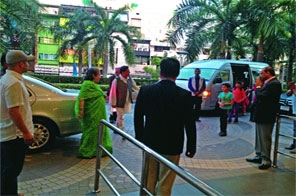Bangkok :
The number of Nepali medical tourists visiting Thailand has increased in recent days. The first class hospitals, high class medical technology, top-class physicians and significantly lower treatment costs have attracted many Nepali medical tourists.
Thailand has also developed itself as the most important and popular medical hub in Asia and worldwide. Thai medical services are renowned worldwide, resulting in a rapid growth in related industries such as spa, Thai massage, Thai herbs, serviced apartments and health tourism.
Some of the renowned people who took advantage of the Thailand medical facilities are former queen Komal, Sita Dahal (wife of Pushpa Kamal Dahal —president of CPN-Maoist) among others. It is also a well-known fact that when former late prime minister Girija Prasad Koirala needed medical care in 2006, he chose to travel to Bangkok’s Bumrungrad Hospital for treatment. At present, former crown prince Paras is also undergoing treatment at Samitivej Hospital.
Western accreditation is also a vital component for confidence in undergoing foreign medical treatments and Bangkok’s Bumrungrad and Samitivej hospitals were among Southeast Asia’s first recipients of the United States’ prestigious Joint Commission International (JCI) certification.
According to the Tourism Authority of Thailand (TAT), 25,728 Nepalis have visited the country in the year 2011. The Thai Embassy Nepal said that they do not have record regarding the medical patients but a significant number visit for medical treatment.
Bumrungrad International Hospital is the main medical tourism hospital in Thailand and one of the biggest in the world. The hospital is state-of-the-art, equipped with top-of-the-line technology and has well-trained staff. Annually, Bumrungrad serves more than 420,000 international patients from over 190 countries.
Kenneth Mays, Hospital Market Director at Bumrungrad Hospital, said that the hospital records around 2,000 Nepali patients annually especially for treating cardiovascular disease, cancer, digestive cancer, neurology and plastic surgery among others.
The cost of medical treatments in Thailand is significantly lower compared to identical treatment in the West and other developed parts of the world. So, many medical tourists from developing countries can also afford it, said the market director.
Bumrungrad is the first Asian hospital accredited by the US-based Joint Commission International in 2002, and 15 hospitals are now accredited in Thailand.
“Thailand’s high standards and healthcare expertise make it a world leader in medical tourism,” said Mays. He said Thailand’s medical professionals are highly qualified. The physicians, surgeons and nurses have been trained to the highest levels, while many specialists have been conducting research and gaining experience at the world’s best medical institutes.
According to TAT, 1.4 million international patients have received medical treatment in Thailand and the number is increasing annually. Statistics show that medical tourism has been a growing segment of Thailand’s tourism and health-care sectors in the past years.
Medical tourism in Thailand is growing at a yearly rate of 16 per cent, while in financial terms the foreign medical services sector is expected to make a whopping 100 billion baht by 2015. Currently, medical tourism makes up 0.4 per cent of the GDP, while tourism overall accounts for six to seven per cent, the third most important economic driver in Thailand.
TAT began promoting medical tourism in 2004, has a detailed medical tourism website that highlights many of the most popular treatments available, including dental work, dermatology and cosmetic surgery, as well as listing reputed hospitals, making it easy for potential visitors to decide on a procedure.
source: http://www.thehimalayantimes.com / Home> Top Stories / by Laxmi Maharjan / March 11th, 2013


